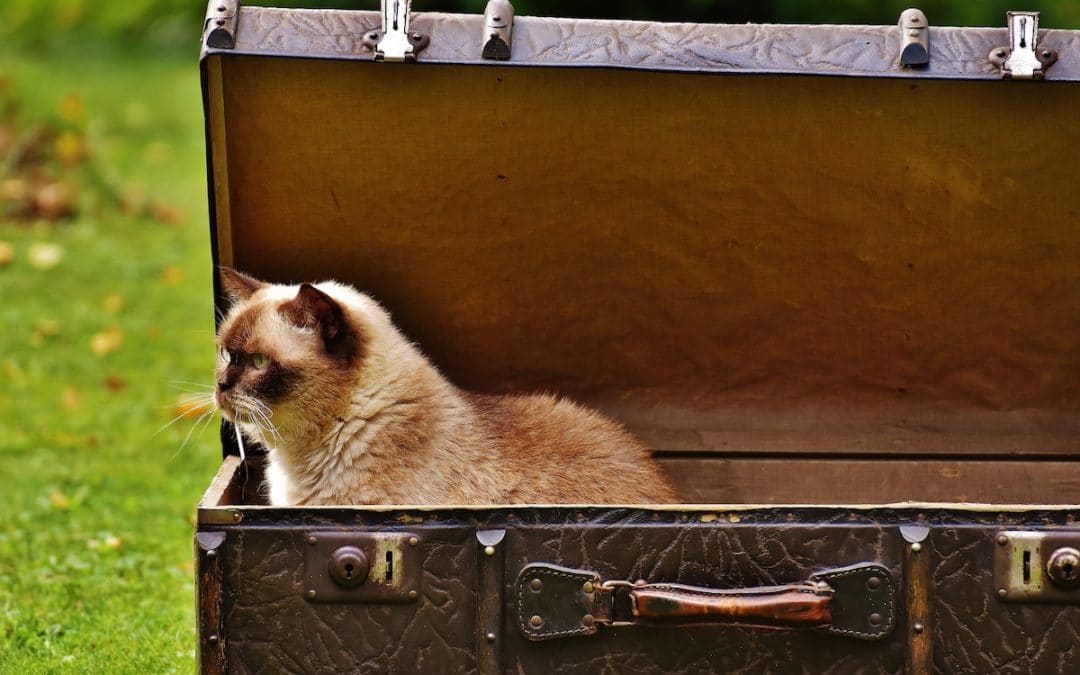Are you moving soon and concerned about how your cat might respond to the process? Learning how to move with a cat is crucial. Moving is a daunting task, and anyone with a pet knows that it adds a layer of stress wondering how they will adjust to the change. Even more than dogs, cats are notoriously sensitive to moving environments.
In this article we’ll talk about how to move with your cat, and why it’s so important to cater to your feline friends’ needs.
Cats Territory
Cats are one of the few pets that connect with territory more than with their owners. They divide the territory into three main zones:
- Core Zone
- Home Range
- Hunting Range
The core range is the house where they live. It is the area that they sleep, play and eat in. Moving them from this area to a new ‘core range’ could be a stressful experience for them.
Therefore, not taking the necessary steps to help make this transition as smooth and calm as possible could make them want to run back to their old core range resulting in a lost pet.
There are 5 Steps that you are able to do to make the transition easier for them to handle.
Step 1: Preparing to Move Homes With Your Cat

There are a few ways to help prepare your cat for the move. One of them is to get your cat used to the idea of moving out by having a few of packing boxes around the place.
Another method which is the complete opposite is to make sure your cat does not see the moving boxes at all. These two methods are contradictions but either could work depending on your cat. One suggestion that you can start with the first method, but as soon as you see that they are freaked out, put the boxes away and go for the second.
If you suspect neither will work you can place your cat in a “daycare” for the day of the move, the day leading up to it and the first two days in the new house.
Step 2: Moving Day
A small breakfast is a good way to start the moving day since you will be keeping to their routine. However, the breakfast should not be too large since it may cause their stomach to get upset. They could feel nervous about moving and giving them too much to eat could end up making them feel slightly ill.
While the actual move is happening in the house and the boxes and everything else are going into the moving vans, your cat should be separated from all this chaos by putting them inside a small, empty room (one of the first rooms that you moved out so that there would be no need to open that door) with some water, a few treats, their litter box, and some of their favorite toys.
It is important to keep this door closed at all times and to make the other people aware that there is a cat behind that door that may be eager to run away. A cat may want to make a run for it because of the changing environment around them and a runaway cat is one of the ways a lost cat is made.
Step 3: Moving Out and In
When you have finished packing up the house and are ready for traveling make sure that your cat is in the carrier that they have become used to. While on the road, make sure that the carrier door is shut well. Do not open it unless it is absolutely necessary and only when you stop in a secure and safe area. Preferably, keep the cat in the car while you check on them.
If your cat looks as if they are very nervous and filled with anxiety you can try to stick your fingers through the grid of the carrier’s door in order to pet them or if you are the one who is driving try to talk to them in an attempt to keep them calm.
Step 4: The New ‘Core Range’

Part One – Establishing Comfort
- When you arrive at their new ‘core range’ makes sure that it is cat-proofed.
- Once you are inside you should pick a small, quiet room in the house that your cat can go in. This is so they get used to the new sights, sounds, and smells of the new house as well as feel safe. Plus, you are able to keep your eye on them and make sure they do not feel alone, scared, or stressed.
- Make sure that they have all their things such as their litter box, treats, food and water bowls, and their toys in the room before you let them out of the carrier.
- Once they are in the room, try to spend as much time as you can in the room with them even if you are just sitting there.
- Also, give them a treat when they explore the room or show any positive signs that they are slowly beginning to get used to their new environment. You want your cat to get used to all that the new place has without them becoming stressed out, panicked, or overwhelmed.
Part Two – Establish a Routine
Once you have completely unpacked (or after two days) and feel comfortable and you think your cat is ready to be let out of the first small room, you can do so.
- Let them go into other rooms of the house in order to explore but just pay attention to where they are at all times.
- Another way to help them explore and to move into the rest of the house is by having another litter box in the place that you want it to be. Every day move their original litter box from the first room, little by little closer to the new one in the new location within the house. This is so they do not get lost or feel confused.
- You can also take a dry cloth and gently rub it on their face so that you have their scent on the cloth. With this, you can dab around the house at cat level so that they have a familiar scent in the new place.
- Give your cat time (it can be anything from a few days to a few months) to get and do not push or pull them to be active in the house. Let them give you the cues, but you can tempt them with treats. A regular routine with a few more smaller meals could also help them adjust since they will not be worrying about getting feed.
Step 5: When to Let Them Explore Outside
Once your cat show interest in going outside into the enclosed yard or garden, you should go with them. But try to go out before their meal time so that they have a reason to go back inside. Another idea you is to take their used litter and sprinkle some around the garden so that they can feel more comfortable there since it has their scent.















